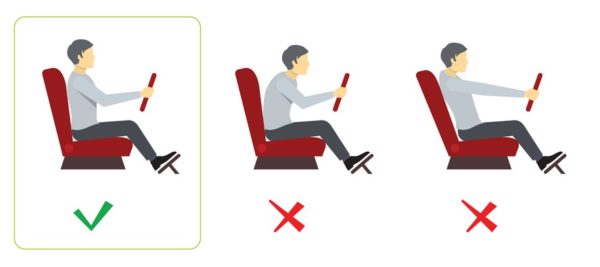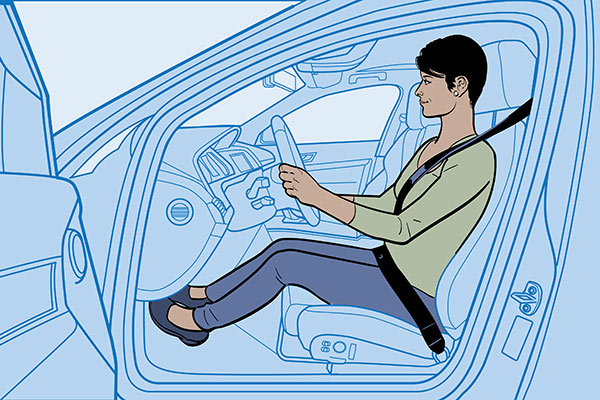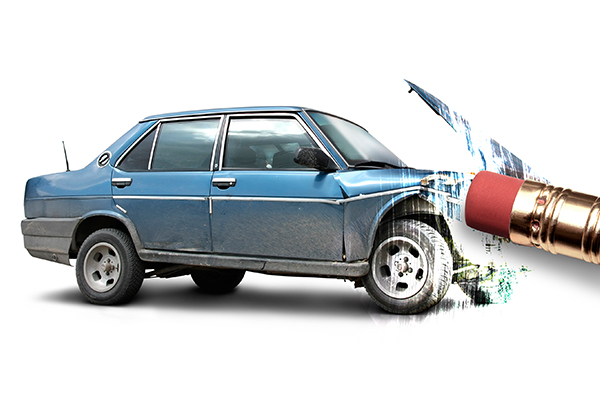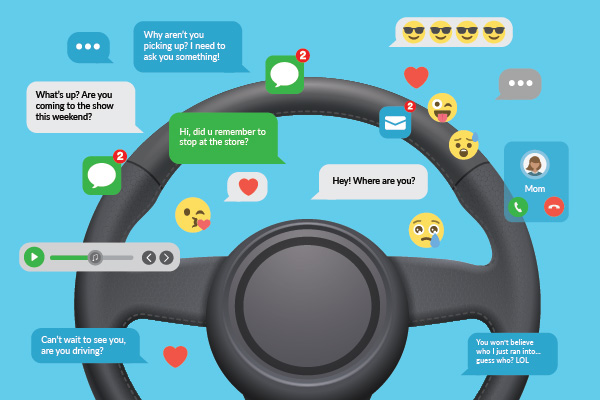An achy back, stiff neck, sore shoulders: The everyday shakes, rattles and rolls of daily commuting can take a toll on your body.
The vehicles we drive are part of the problem. Some car seats don’t adequately accommodate the curve of the lower back, putting additional strain on the spine. And compact cars may lack legroom and head space, forcing some drivers to contort their bodies into unhealthy positions just to operate the vehicle.
But it’s not always the car’s fault, says Dr. Ginger Edgecombe Dorsey, Ph.D., Ergonomics Program Manager for the USDA Animal and Plant Health Inspection Service (APHIS). Sometimes the problem is simply how we sit. In her ongoing poll of USDA employees, she finds that poor driving posture can lead to an increased risk of discomfort in the neck, back, shoulders, arms, wrists, fingers, legs and feet. Over time, she says, bad posture could result in chronic pain, making you vulnerable to more injuries.
And sore limbs may be the least of it: One study found that poorly positioned drivers also have an increased risk of serious injury if they get into an accident.
Fortunately, you can alleviate many posture-related discomforts with proper adjustment of the driver’s seat and mirrors. Here’s what Dorsey recommends.
 1. Support Your Back
1. Support Your Back
Slide your tailbone as close to the seat back as possible. Aim for a two- to three-finger gap between the back of your knees and the front of your seat. If your vehicle doesn’t allow for the proper position, a lumbar or back cushion may help.
2. Lift Your Hips
If you can, adjust your “seat pan” (the part you sit on) so that your thighs are supported along their entire length and your knees are slightly lower than your hips. This will increase circulation to your back while opening up your hips.
3. Don’t Sit Too Close
You should be able to comfortably reach the pedals and press them through their full range with your entire foot. Safety is also a consideration here; this study suggested that drivers whose chests were closer to the wheel were significantly more likely to suffer severe injuries to the head, neck and chest in front- and rear-end collisions.
4. Get The Right Height
Make sure your seat raises your eye level at least three inches above the steering wheel while allowing sufficient clearance between your head and the roof.
5. Lean Back (A Little)
The angle of your seat back should be a little greater than a perpendicular 90 degrees. At 100 to 110 degrees, the seat will put the least pressure on your back. Leaning too far back forces you to push your head and neck forward, which can cause neck and shoulder pain and tingling in the fingers.
6. Set Your Headrest
Set the top of the headrest between the top of your ears and the top of your head; it should just touch the back of your head when you’re sitting comfortably. The headrest is also important in reducing whiplash injuries in the event of a rear-end collision, says NHTSA—so important, in fact, that standards were developed for it.
7. Use Lumbar Support
If your car has adjustable lumbar support, set it (using both the front-back and up-down controls) so you feel an even pressure from your hips to your shoulders. If your car doesn’t have automatic support, a lumbar pillow or even a rolled-up towel can help.
8. Adjust Your Mirrors
Prevent neck strain by making sure your rear-view and side mirrors are properly adjusted; you should be able to see the traffic behind you without having to crane your neck.
9. Take Breaks
Even when you’re perfectly situated in the driver’s seat, fatigue will inevitably set in, especially when you’re driving for long periods. Listen to your body. And take periodic breaks: Park safely at a rest stop or other designated stopping area to get out of the car and stretch.
Managing your auto insurance policy shouldn’t be a pain in the neck. See why GEICO Mobile was ranked #1 by the Keynova Group’s Mobile Insurance Scorecard for 5 years running and download the app today.
Read more: Everything you need to know about distracted driving.
By Robert Edbrooke









John W. Newhouse says,
Very nice basic info. I do experience bac pain from time to time.
Marilyn Rommel says,
These tips cannot be applied to a 5 foot woman driving most cars. Too close to steering wheel, head rest not right. Is there a way to extend the gas and brake pedals legally?
Pamela Lodefink says,
I love articles like this one. I have driven for 60 years and the last time I received a ticket was12 years ago. (speeding on the freeway 7 miles over the posted limit.) Most of the formal education about driving came from Driver’s Ed, a long time ago.
These articles are very helpful to update my expertise and awareness of the process of driving. It can feel so automatic that it is easy to almost forget about it.
Do more of these.
Thanks
Linda Tyree says,
These are great tips. Thanks
Alejandro rivas says,
Very important tips for every one driver shure know.
Samuel says,
Thank you so much! We need such life lead info, helpful in everyday movements.
Gwendolyn Hobbs says,
Thanks great points
Rhodesia says,
Good morning. Thank you for these great tips. I realized my posture needs some improvement, even though I purchased a lumbar support cushion.. The upper seat belt rubs my neck , and collarbone area, and causes redness, and discomfort. I know now I have to purchase a seat belt pillow/cushion. Happy holidays to you, and my fellow motorist.Travel mercies to all.
Sue Harman says,
Excellent pointers. Thank you.
Christos Koliotasis says,
Thank you for the information..!!
Gertrude Beuing says,
Thank you for the information
Mark S Warren says,
Thank You.
Hector Rodriguez says,
Posture tips very helpful, I will try them..
Thanks
Byron says,
This was helpful to me. My back should feel better as soon as i implement these tips. Thanks
ALLEN chow says,
thankyou Geico this very good advice .